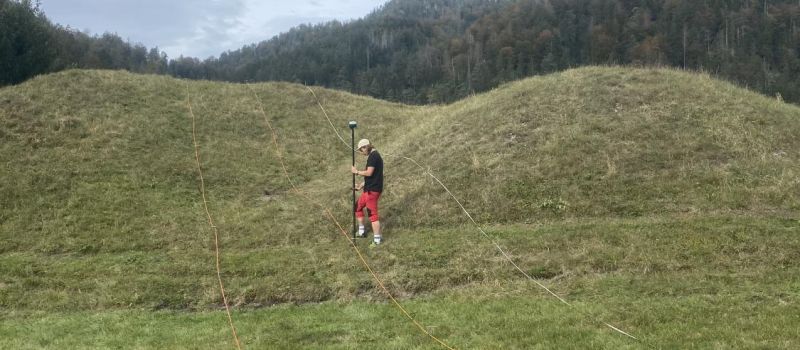Moving mountains – landslides as geosystem services in Austrian geoparks (movemont.at)
Landslides in the Austrian UNESCO Global Geoparks.
Landslides are prevalent phenomena in mountainous regions, constituting a fundamental aspect of their gradual degradation over time. From a societal perspective, these occurrences can pose both risks and disasters, which have spurred extensive research efforts. Nevertheless, landslides also hold the potential to embody valuable natural and cultural heritage while providing various benefits to society. These facets remain relatively unexplored and can be incorporated within the somewhat underutilized concept of geosystem services (e.g. Argentin et al., 2021)
Within this context, landslides offer insights into the functioning of Earth’s surface systems. UNESCO Global Geoparks (UGGps) serve as ideal settings for investigating and emphasizing geosystem services related to landslides. This is especially true in Austria, where the three existing UNESCO Global Geoparks (Karawanken/Karavanke, Erz der Alpen and, Styrian Eisenwurzen) are distinguished by the presence of a wide array of landslide types and magnitudes.
Each of the three Austrian UGGps showcases landslide processes and the associated landforms. These landslides span a wide range of occurrence times, from prehistoric to recent events, often occurring in former mining areas. They vary in volume, from small rock fragments to approximately one cubic kilometre in size. Mechanisms and velocities also differ, ranging from slow creeping movements to extremely rapid debris flows and rock avalanches. On one hand, these landslides pose threats to human populations and disrupt critical infrastructure. On the other hand, they offer mineral resources and hold ecological and cultural significance. See also Hejl et al., (2018).
Research on landslides in the Austrian UGGPs is diverse. For instance, Geologist from the Karawanken/Karavanke UGGp developed a map that assesses landslide susceptibility and runout for shallow landslides in the province of Carinthia, which includes the Austrian part of the UGGp. In contrast, Geologist from the University of Graz documented and analysed a remarkable event that significantly impacted the landscape in the eastern part of the Styrian Eisenwurzen UGGp: the Wildalpen rock avalanche, which occurred between 5900 and 5700 years ago. This landslide event involved a massive volume of around one cubic kilometer, and its deposits stretch over a total length of 12 km in the Salza Valley. The unique landscape created by the rock avalanche serves as a source of drinking water for Vienna. However, its full potential for geological, geomorphological, hydrological, ecological research, and environmental education has not yet been fully explored. See also Mergili et al. (2021).
Based on these data the research project movement.at was devised aiming to better understand these phenomena. The project aims are the following:
Constructing a comprehensive theoretical framework that encompasses landslide processes and their societal significance across various temporal and spatial scales. This framework will address both the opportunities and risks associated with landslides. In doing so, we will adopt the concept of geosystem services, a term that has appeared sporadically in the literature as a derivative of the more commonly used ecosystem services but has not yet gained widespread recognition.Conducting a uniform mapping and characterization of landslides within each of the participating UNESCO Global Geoparks. This will be achieved by employing a standardized methodology and utilizing existing databases as the foundation for subsequent investigations. Our research will delve into the role of landslides in shaping karst landforms and advancing karst-related studies (Bauer, 2015) Additionally, we will explore how landslides contribute to biodiversity, including their significance in providing habitats for rare or endangered plant and animal species, as well as their influence on microbial diversity in the soil. See also Petermann et al. (2021)
Creating an integrated set of tools for GIS-based simulations of landslide predisposition and dynamics. This will entail a focus on the large-scale analysis of stress distribution in mountainous regions and its impact on slope stability. We will also investigate the dynamics of slow-moving mass flows, complex deep-seated landslides, and slope deformations. These simulations will serve educational purposes, potentially through immersive virtual reality visualization.
Design and implementation of strategies to leverage landslide occurrences for broader environmental education. The participating UNESCO Global Geoparks will serve as pilot areas for these strategies. As landslides often result in spectacular phenomena that shape remarkable landforms, they offer a compelling means to generate enthusiasm for geoscientific topics among the public. Consequently, they are valuable for demonstrating intricate geomorphological processes.
Geohazards education and dissemination
The three UGGps in Austria have a basic knowledge transfer regarding natural hazards in their territories. All Geoparks work closely with their local schools, inhabitants, tourists or other target groups. Styrian Eisenwurzen and Ore of the Alps UGGp have both climate change adaptation regions in their area. These are funding programs from the national Austrian government to disseminate the challenges of natural hazards. Karawanken/Karavanke and Ore of the Alps UGGp have both well established, state-of-the-art visitor centres which also raise awareness on Geohazards for various target groups. Finally, Styrian Eisenwurzen has project days related to the topic for schools and other organizations. These are some examples regarding dissemination and education activities on mass movements and natural hazards in Austrian Geoparks. The Geoparks management bodies have been working strongly on these topics and hope for further development throughout the project movemont outputs.
The project will be carried out by a team of researchers from the Universities of Graz and Salzburg, alongside environmental education experts from the three collaborating UNESCO Global Geoparks. It will be integrated into the international research and geopark networks through various partnerships.
To illustrate a planned pilot initiative, the Styrian Eisenwurzen UNESCO Global Geopark intends to present the Wildalpen landslide to its visitors at the Spring Water Museum of Wildalpen. This museum presents an excellent opportunity to incorporate this topic into its exhibition since it is situated within the area affected by the rock avalanche, aligning with the exhibition’s thematic focus. The museum is also planning to launch a new exhibition within the next two years, providing a seamless opportunity to integrate this pilot initiative into the upcoming exhibition, which will cover subjects related to geology, nature, and local history.
More Information: www.movemont.at









